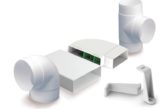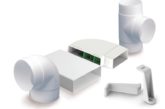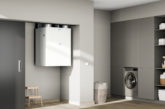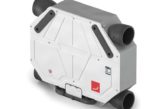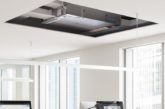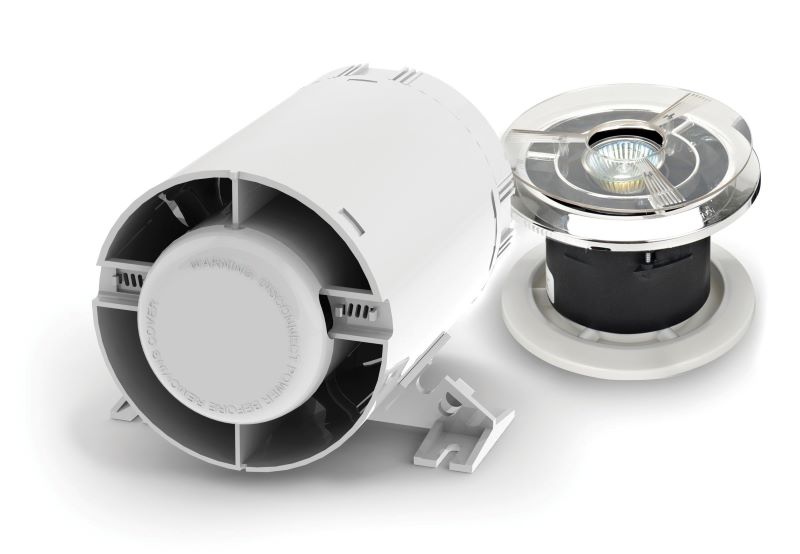
Paul Williams, Domus Ventilation Product Manager, looks at how to select and install a domestic extract fan to ensure high performance and longevity.
The humble mechanical extract fan: the unsung hero of the ventilation mark et when compared to whole house ventilation systems. Yet choosing the right extract fan is essential if it is to perform to the desired standard and to meet Building Regulations Part F Ventilation.
Types of extract fans
There are two types of intermittent extract fans to choose from – axial and centrifugal –both of which are suitable for use in wet rooms, including bathrooms, toilets, kitchens, utility rooms and ensuites.
The simplest to install, axial fans are designed to work with short duct runs, typically no more than 1.5m, which connect directly to an external outlet or grille. Most kitchens and bathrooms with an external wall are suitable for axial fans. Axial fans are the lower cost option.
Where longer duct runs are necessary, often because the room to be ventilated is in the centre of the house, centrifugal fans are the preferred option as they produce more pressure to overcome resistance encountered in longer duct runs – normally up to a maximum run of 6m. Typically, they are quieter than axial fans, so may be a better option for ensuites.
In addition to standard centrifugal and axial fans, there are also duct-mounted inline fans which come in both formats, as well as mixed flow models which are most frequently used in longer duct runs up to 6m. Inline fans are not installed within the room itself – frequently in the ceiling void or attic – but are connected to the room via ducting mounted with a decorative grille at the end. This makes them ideal for installation in splash zones. As installation of inline fans requires longer ducting, they are mostly used in new builds and major refurbishment projects.
Selecting the right fan
Domestic extract fans come in two sizes: 100mm and 150mm. As you would expect, the larger fans are for larger bathrooms (typically greater than 9m²) but would also be beneficial in heavy usage bathrooms and those where there is no natural ventilation.
As well as size, the fan’s performance needs to be taken into account. Measured in litres per second (l/s) or metres cubed per hour (m3/hr), the air extraction rate is vital. To meet Building Regulations, the minimum extraction rate for a bathroom extractor fan is 15l/s. Domus Ventilation fans are all Building Regulations compliant, with extract volumes up to 48.8l/s for axial fans. Ultimately, when choosing your fan, refer to the manufacturer’s performance curve, which shows the relationship between the static pressure capabilities of a fan compared to its extraction rate, plus pressure loss in ducting, to determine the final extraction rate.
In control
We have done research into which are the most popular control options and they are at the opposite end of the market financially. The basic timer and pull cord model remains popular as a cost-effective option, whilst the more advanced fans with humidistat or combined humidistat & timer that react to a significant change in humidity, are prevalent in higher end properties. Our new intermittent axial fan range – the DBF100 100mm fan and the DKF150 150mm fan – are available with these different control options.
PIR based controls that activate the fan on the detection of movement are also available, but are less popular.
Avoid common mistakes
The biggest error we see when it comes to extract fans is not the fan directly, but the ducting, which can make or break any ventilation system.
Use rigid, not flexible ducting which causes a lot more air resistance (and noise) and can be damaged easily. Be sure to use the correct ducting size: if the fan has 150mm diameter spigot, use 150mm ducting. Keep ducting as short and straight as possible as ducting creates air resistance, which reduces airflow.
Lastly, it might seem obvious, but you’d be surprised how often this mistake is made: if you are drilling through an external wall, make sure that the core drill is the right size based on the fan spigot. You don’t want it too small as otherwise the fan won’t fit through the hole, but clearly if it’s too big you’ll have to do some remedial work to the wall.


